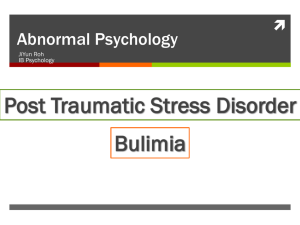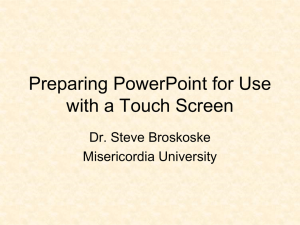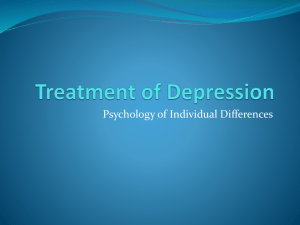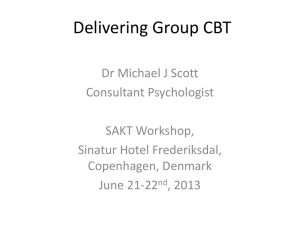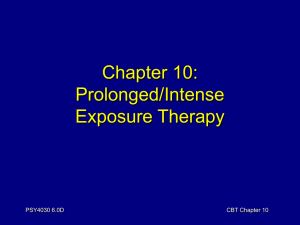Abnormal Psychology: implementing treatment
advertisement
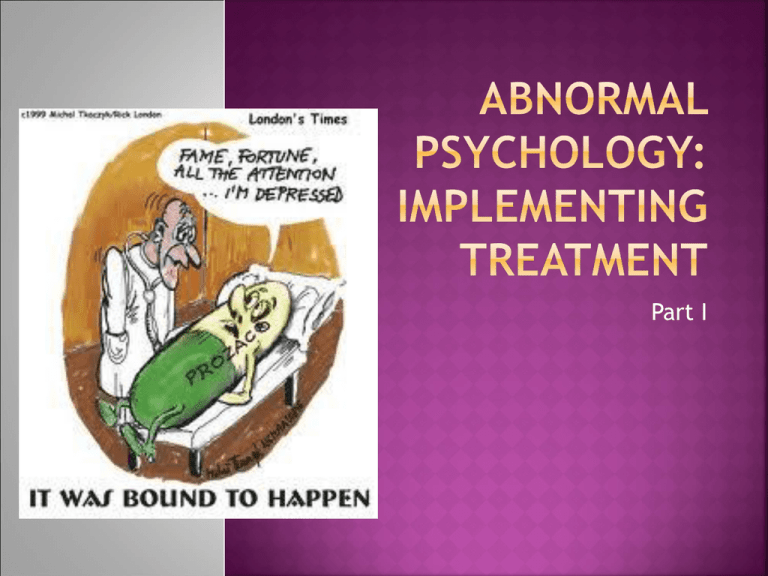
Part I Biological Drug Therapy Cognitive (Psychological) Individual Therapies Social Group Therapy Must we know the causes prior to providing treatment? Can we identify specific causes of disorders? Drugs are used due to a chemical imbalance Antidepressants Elevate the mood of people suffering from depression Serve to increase or decrease levels of neurotransmitters Selective serotonin re-uptake inhibitors (SSRIs) Prozac (fluoxetine) • • Effective in short term treatment (60-80%) Kirsch and Sapirstein (1998/2008)) – (1998) Analyzed results 19 studies of patients who had been treated with the antidepressant prozac • – Found that antidepressants were only 25% more effective than placebos, and no more effective than tranquillizers. (2008) review of 47 clinical trials on the effectiveness of antiedepressants • Found that antidepressants are not more effective than placebos, and that patients can improve without the drug. Also the drug should only be prescribed in most depressed patients when other therapy has failed. Blumenthal EXERCISE was as effective as SSRIs Leuchter et al. (1999) and Witte (2002) Drug treatment was as effective as placebos. Changes to same area of brain (PREFRONTAL CORTEX) Drug lessoned activity in prefrontal cortex Placebo increased activity in prefrontal cortex • Elkin et al. (1989) 28 clinicians worked with 280 patients diagnosed with major depression. Group 1: Antidepressant drug (imipramine)50% recovered – Group 2: Interpersonal therapy (IPT)- 50% recovered – Group 3: Cognitive- Behavioral therapy (CBT)50% recovered – Control Group: Placebo pill w/ weekly therapy sessions- 29% recovered – • – All patients were assessed at the: – Start – 16 weeks – 18 months It did not matter which treatment the patients received, all the treatments had the same results. The groups with drugs had faster results. • • • Distorted Cognitions cause depression Cognitive psychologists (Aaron Beck, 1960’s) developed Cognitive Restructuring. Negative self-schemas bias a persons thinking 1. Identify negative, self critical thoughts 2. Note the connection between negative thought and depression 3. Examine each negative thought and decide whether it can be supported 4. Replace distorted negative thoughts with realistic interpretations of each situation Aims of CBT 1. Identify and Correct faulty cognitions and unhealthy behaviors (Cognitive Restructuring) 2. Encourage people to increase gradually any activities that could be rewarding (coping strategies) – Teasdale (1997) • Teach the client meta-awareness, the ability to think about their own thoughts • Riggs et al. (2007) studied effectiveness of CBT in combination with either a placebo or an SSRI – 126 adolescents suffering from depression and substance abuse • • Found: – 67% Placebo and CBT were judged as “Very much improved” – 76% SSRI and CBT were judged as “Very much improved” CBT is criticized for focusing on symptoms rather than causes • Couples Therapy (marital problems) – focus on teaching couples to communicate and problem-solve more effectively, while increasing positive, pleasurable interactions and reducing negative interchanges. – Toseland and Siporin (1986) reviewed 74 studies comparing individual and group treatment. • • • • 75% Group treatment was as effective as individual treatment 25% Group treatment was more effective In no case was individual treatment found to be more effective than group treatment. group therapy is more cost effective than individual therapy. McDermut et al. (2001) meta-analysis (48 studies) 43 studies showed reduction in depressive symptoms following group psychotherapy 9 showed no difference between group and individual 8 showed CBT to be more effective than group • Factors to consider: – – Group Cohesion: all people must belong to the group Exclusion: any characteristics that should be excluded? • – Substance abusers, married men, certain health conditions Relationship with Therapist: therapist is not “one of us”. Therapist must show empathy to group members and try to understand their reality Multifaceted Approach to Treatment Biopsychosocial (bio-psycho-social) perspective Prescribed Antidepressants: drugs: Antidepressants used because many PTSD patients suffer from depression. Marshall (1994) found that improvements in depression contribute to improvement in PTSD, regardless of how PTSD is treated. Tranquilizers: Valium and Xanax – regulates anxiety levels CBT and PTSD – “talking about the trauma” Foa (1986) argues there are four goals of CBT when treating a person with PTSD: 1. 2. 3. 4. Create a same environment that shows that the trauma cannot hurt them. Show that remembering the trauma is not equivalent to experiencing it again Show that anxiety is alleviated over time. Acknowledge that experiencing PTSD symptoms does not lead to a loss of control. CBT has had positive results. Keane (1992) found that patients become initially worse in the initial stages of therapy, and the therapists become upset when they hear about the patient’s experiences. • • • • • As a result of such traumatic events as school shootings, we have seen the development of a field of psychology called traumatology. Crisis intervention are teams of psychologists that arrive at the scene to help the survivors and witnesses of a traumatic event. It is based on the assumption that it is best to intervene with survivors 24 – 72 hours after the traumatic incident, before PTSD sets in. Its effectiveness, however, is open to debate. First, the majority of people who experience trauma never develop PTSD. It appears that PTSD manifests itself in approximately 25% of people exposed to trauma. In cases of rape and ethnic cleansing, the numbers are significantly higher. Mayou et al (2000) argues that crisis intervention may do more harm than good; Immediately following a disaster, people are best served by the social support usually available to them in their families and communities; the coercion to be treated by strangers, even if well-intentioned, is not helpful and may even be intrusive and harmful. • • • • In his work with Bosnian refugees, Stevan Weine (1998) has employed testimony psychotherapy as means of helping patients overcome their PTSD. According to Weine, traditional treatment is said to work by deactivating “networks of fear” in the psyche. Testimony is based on theories that consider collective traumatization to be at least as significant as individual traumatization. Bosnians approach matters of traumatization as a matter of collective as well as individual experience. What was targeted in the genocide was not only their individual lives, but also their collective way of life. • • • An essential component of testimony therapy is the creation of an oral history archive to collect, study, and disseminate the survivors’ memories. This gives meaning and purpose to the experience of the survivor. Testimony therapy is integrative. It is an opportunity for the survivor to assimilate dissociated fragments of traumatic memory and to associate affective and cognitive aspects of the experience through the guidance of a therapist who has adequate knowledge of the historical events that the survivor has experienced. Testimony provides a time for an individual to look back over and reconsider his or her previous attitudes concerning ethnic identity, forgiveness, and violence. It also allows them to consider how their experience has affected how they feel about their lives today. For the survivor, the process of testimony permits the “entry into meaning.” • • • In Weine’s study, all patients were diagnosed by using the PTSD symptom scale, which had been translated into Bosnian and then back translated for accuracy. All testimonies were conducted in Bosnian, translated into English, and then translated back so that the interpreter and the survivor could together correct mistakes and add possible new recollections and details. The final document was given back to the survivor at the final session, and the survivor signed the document – verifying its accuracy. There are many survivors who are highly disinclined to seek or accept psychiatric treatment from a clinician but who would participate in testimony psychotherapy in the community. Weine found that the rate of PTSD decreased from 100% at pre-testimony to 75% post-testimony, 70% at 2-month follow up, and 53% at 6-month follow-up. Since people suffering with bulimia often suffer from depression, antidepressants and SSRIs are used to treat bulimia. McGilley and Pryor (1998) treated bulimic patients with Prozac Reduction in vomiting of 29% of those receiving the drug There was only a 5% reduction in vomiting for those that were receiving the placebo. Goldstein et al. (1995) found that Prozac reduced binge eating 51% compared with 17% given the placebo. Most bulimics are in denial about their problem, it is estimated that 90% of those that suffer from eating disorders do not seek treatment. • The most widely used individual therapy to treat bulimia is the CBT. – – – – – Addresses cognitive aspects of bulimia, such as obsession with body weight, negative self-image, “all or nothing” thinking, and binge eating and vomiting. Aim: restore some control of eating, but avoid dieting because this is known to trigger binge eating. Patients keep a log of what they eat, and how it makes them feel. They are taught to identify and deal with symptom triggers. Patients learn cognitive techniques for improving selfesteem, and how to develop adequate feelings and avoid damaging thought patterns. Wilson (1996) found that CBT was superior to medication alone and that the combination of CBT and medication was superior to medication alone. Wilson (1996) found that 50% of patients who receive CBT stop binge eating and purging. The remaining patients only show partial improvement, and some do not benefit at all. Use of group therapy for bulimia is growing McKisack et al. (1997) found that group therapy was widely used and that it was relatively effective, especially if people were matched by certain characteristics, and it was long and had additional treatment components. • Concerns for group therapy: – – – – – Patients may get negative ideas from each other. Ways to hide weight loss or induce vomiting. The group may adopt a pessimistic view toward improvement, and this may be resistant to change. The group may reinforce that such eating behaviors are normal. Competition from the group may lead members to engage in behavior to gain attention of the therapist. Well-meaning group members often become co-therapists. They insist change and judge other group members.


